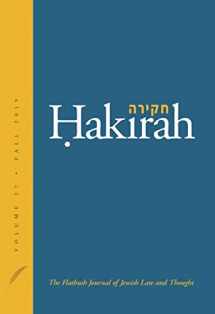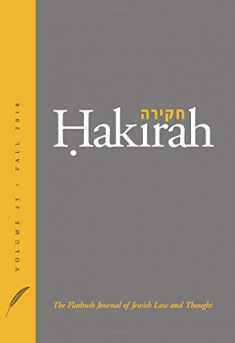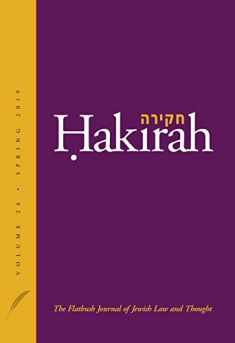
Hakirah: The Flatbush Journal of Jewish Law and Thought: (Volume 27)
Book details
Summary
Description
Ḥakirah is honored to present lectures given approximately 70 years ago by Ha-Rav Yosef Dov Soloveitchik, zt”l on the opening verses of the Torah. In the five lectures presented here as the first of three installments, the Rav’s focus is on the question raised by the Amora Rav Yitzḥak as to why the Torah dwells on the story of creation and what philosophical truths we are to learn from it. Further delving into the Rav’s philosophical works is a review essay on Nietzsche, Soloveitchik and Contemporary Jewish Philosophy. The reviewer argues that “R. Soloveitchik took secular philosophy as a foil rather than as a foun-dation for his own hashkafa, which was deeply rooted in Jewish sources.”While the Rav’s work was often dedicated to harmonizing Torah hashkafa and halakha, in our Jewish Thought section we deal with two other twentieth-century Jewish thinkers who emphasized one above the other and who consequently are considered on the fringes of Orthodoxy. In an “Introduction to Rabbi Abraham Joshua Heschel’s Philosophy” we see that for Heschel the values and philosophy of Judaism overshadowed the importance of halakha. On the other hand, in “Sanctifying Our Choices: The Solution to the Paradox of Orthodoxy,” an essay on the thought of Prof. Yeshayahu Leibowitz, we see that his thinking was the reverse, that all emphasis should be placed on halakha.The thought of another famous thinker who dealt with the challenges of modernity is explored in “Rabbi Samson Raphael Hirsch on Jews in a Non-Jewish World,” which features the first English language translation of a book review by Rav Hirsch where he expounds about the appreciation Jews can get about Judaism itself from reading works that deal with Christian life. And in “The Life and Work of Dr. Menachem Mendel Yehudah Leib Sergei: A Torah U-Madda Titan in the Early Twentieth Century” we are introduced to and inspired by a unique but overlooked Jewish physician “who combines Torah, fear of G-d, and wisdom in an extraordinary way.”Several articles deal with censorship. In our Forum section, two scholars debate whether ArtScroll censored Rashi to disguise a non-traditional opinion of his, and present differing views on Rashi’s inter-pretation of the term tikun soferim. In “The Brothers Tugendhold & Jewish Censorship in the Nineteenth Century: Addition and Subtrac-tion in the Warsaw 1853 Ḥumash,” the author examines the motives and guidelines behind Jewish self-censorship a century ago. In “The Ban on R. Yeḥiel Michal Pines in Jerusalem and his relationship with his brother-in-law, Rabbi David Friedman of Karlin,” we read of another type of “censorship” targeting what the Zealots of Jerusalem considered the intrusion of foreign influences into the Holy City of Jerusalem. In our Minhag section in an article entitled “Is it Permissible to turn one’s back to the Hekhal or Kotel During Qabbalat Shabbat?” the author objects to what he considers an errant new custom.A Hebrew article on Halakha looks at the RCA’s prenuptial agreement, calling for its wider acceptance, while an English-language article “A Prenuptial Agreement by and for the Ḥaredi Community” presents a new such agreement that has haskamot from the Ḥaredi world.Apropos of the season of Teshuva, a comprehensive article on “Rehashing The Free Will Question” examines all the explanations that have been put forth over the generations to deal with this challenging issue. In our Torah and Medicine Section “Epigenetics Revolution: The Power to Self-regulate and Control Human Behavior” issues of halakha and hashkafa are addressed, as the authors use the latest advances in science to propose “that there might be a molecular/cellular understanding, based on epigenetics, of how a lifestyle devoted to doing mitzvot can enhance this capacity to control behavior.”


We would LOVE it if you could help us and other readers by reviewing the book
Book review





